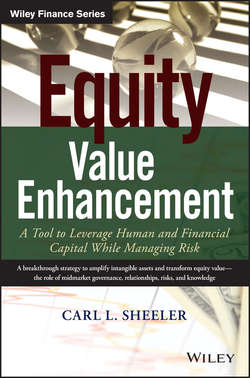Читать книгу Equity Value Enhancement - Sheeler Carl L. - Страница 15
На сайте Литреса книга снята с продажи.
Chapter 1
Value ABCs
Capital and Risk
ОглавлениеCompany size can be a significant consideration when it comes to risk, especially with regard to securing capital. As you might expect, larger companies usually have more options and better access to the capital markets as well as better rates and terms. A $1 billion company may have funding sources bending over backwards to provide financial support while a $25 million company may need its owner to make a personal guarantee to be considered for a loan/credit facility.
The less risk perceived, the better rates and terms offered. That can pay huge dividends for larger companies, with which capital sources, such as banks, are more likely to share risk. However, size is not an absolute because growth and niche market dominance are examples of factors that could suggest a smaller company may have the potential of less risk and higher value. Sharp company owners have an idea what their company-specific risk rate is and how to spread risk by having debt allowing the lender to share the risk.
Let's use for illustrative purposes only the previous example of the $50 million company with the $10 million net cash flow and an assumed 20 percent risk rate. Let's assume our research of comparable companies indicates the optimal level of debt to equity is 50/50. So, we determined that 50 percent has a 20 percent rate for equity. This would be shown by (1 – .50).20 = .10 or 10 percent allocated to equity.
Let's then say that interest rate from the lending source is 5 percent and since interest expenses are tax deductible, that the combined state and federal tax rate is 40 percent. That means that the true cost of capital is (1 – .40).05 or 3.0 percent. Since debt represents half, we now have our new rate of (1 – .50).03 or 1.5 percent. The 1.5 percent debt rate is combined with the 10 percent equity rate for the weighted average cost of capital (WACC) of 10 percent + 1.5 percent = 11.5 percent. This is 42.5 percent lower than the 20 percent rate or risk for equity alone without debt. This improves the market value of invested capital by sharing risk with the note holder.
Remember, the lower the risk, the lower the rate. The lower the rate, the higher the pricing multiple and value.
Finally, assume the $25 million debt allows the company to produce twice the widgets in half the time, reducing labor expenses. So, despite the new interest expense and repayment of principal, the increased profits are $15 million versus the $10 million.
This means the value of the company is $15 million/11.5 percent or $130.5 million (rounded) less $25 million in debt or $105.5 million in value. This is more than twice the $50 million value even prior to finding other areas where risk may be mitigated and/or minimized. This is why as a strategic value architect, it is possible to claim that in as brief as 24 months a company can feasibly increase its value by 100 percent and often more. Obviously, there are myriad other ways to accomplish this either by organic growth or through acquisition as long as synergies are achieved.
Needless to say, overleveraging may result in high sensitivity to declines in growth and inadequate cash flow to service debt. Most seasoned CFOs know leverage is a single arrow in the business's quiver to shift or reduce risk.
Yet, knowing how to get there – to create value – still is not common knowledge. Keep in mind the founder/owner is a rare breed. She or he is thinking “what if” through the opportunity-lens; whereas, advisors often think “what if” through the risk lens. Therefore, the goals of trusted advisors should include helping clients build and create value by ensuring they're aware of how to enhance their intangible assets' value and the options to do so. Advisors must also recognize that owners have limited time to shepherd growth, so having a plan is insufficient. Having resources to execute the plan is what's needed. Successful business owners and their advisors already know it's not simply selling more services and products profitably.
Here's the more surprising issue to make the point. Let's say it takes $500,000 in advisory expenses to achieve this feat of an extra $50 million in value. Who would say “no” to the proposition of for every dollar paid $100 is returned? If a prospect or a client or an advisor says “not interested,” then they may not be ready to invest in themselves.
The point here (as will be explored further in Chapter 2 addressing the focus on trusted advisors) is the discussion needs to be reframed from hourly rates (fees for service) to value, milestone success, participation fees, and/or project billing. Otherwise, there is no perceived connection between services rendered and value created. (Author note: I like a combination of project and participation fees as it conveys to the client that I have skin in the game and the client's success is my success.)
